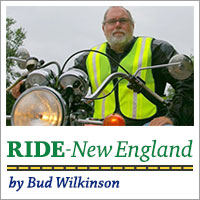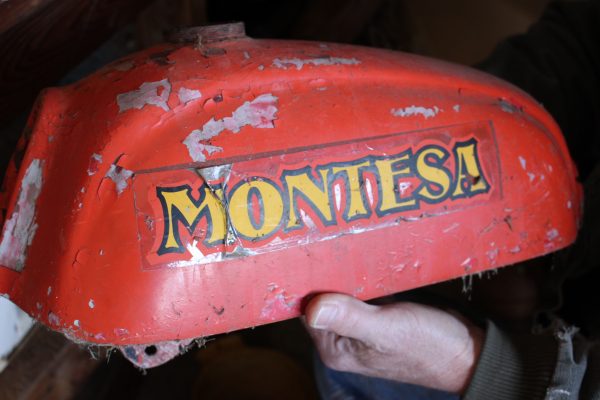The email from Bjorn “Bob” Bagn that arrived on Jan. 6 instantly caught my attention. The subject line revealed that he was 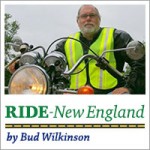 offering two Montesa basket cases as freebies. “Little by little, ‘galloping geriatrics’ has caught up with me,” he explained. “With two metal knees, and at 84 years, I think my days of dirt-bike riding are over.”
offering two Montesa basket cases as freebies. “Little by little, ‘galloping geriatrics’ has caught up with me,” he explained. “With two metal knees, and at 84 years, I think my days of dirt-bike riding are over.”
Free motorcycles? What rider with a sliver of space in the garage wouldn’t be interested?
Bagn gave an additional reason for wanting to divest the bikes. “My wife has threatened to throw salt and sand in the tank if I restore my ‘babies,’” he wrote, neglecting to say whether she meant his car’s gas tank or one of the tanks to the motorcycles.
After providing some details on the Montesas, including the fact they were 250cc Scorpion models from 1970, Bagn asked if I might know of anyone who might like them. I responded that I indeed knew some local guys who ride Spanish dirt bikes and that I’d get back to him.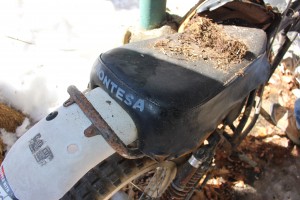
I immediately contacted Tim Sparks of Goshen with whom I sometimes ride. He owns a Spanish-made Ossa and is a member of SMOG, the Spanish Motorcycles Owners Group. Bagn’s offer piqued his curiosity, too, so we arranged a visit a few days later. However, only hours before the appointed meeting time, Bagn called to say that he’d just fallen and had possibly broken his hip.
Consequently, it wasn’t until a week ago Sunday that Sparks and I drove up a lengthy, unpaved driveway in a rural section of northwest Torrington to Bagn’s sidehill house. Before he even stepped outside on to the second floor deck to greet us, we’d already spotted one motorcycle, covered by a tarp and resting against a support post underneath the deck.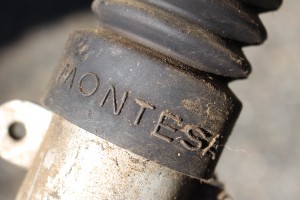
It turned out to be a frame sans engine. It was heavily rusted, and so were the shock absorbers. Remnants of a mouse nest rested on the seat and the tires were frozen into the dirt. Upon closer look, Sparks noticed, “It’s got the original gaiters. Says ‘Montesa” on them.”
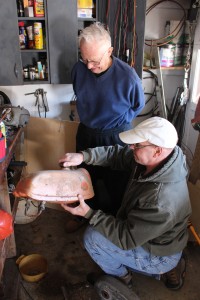 It took a few minutes and the help of cane for Bagn to get downstairs from the living quarters and open a door to the basement garage. Since that first contact back in January, he’d had a hip replaced to fix what had indeed turned out to be a fracture.
It took a few minutes and the help of cane for Bagn to get downstairs from the living quarters and open a door to the basement garage. Since that first contact back in January, he’d had a hip replaced to fix what had indeed turned out to be a fracture.
Inside the garage, sitting on workshop shelves, tucked into corners and wedged in crevices were parts from the two bikes – engines, gas tanks, forks and countless other items. As he retrieved them for inspection, Bagn shared his riding background.
He was born Oslo, Norway (and still has the accent to verify that fact). “I grew up with motorcycles and skis,” he said. In 1949, he was drafted into the Norwegian army. Training took place in occupied Germany. Because of his linguistic skills, he was transferred to a British artillery unit in Germany. After his discharge in 1951, he attended the University of Manchester in England.
“I used to ride as a means of commuting between England and Norway,” he said, recalling that he initially used a single-cylinder, 350cc BSA to get the job done. The Beezer eventually gave way to another 350cc machine, a Matchless. “I did 140 (miles per hour) on that with a single cylinder. It was wild. It just kind of cranked it up at 90 miles per hour into fourth gear,” he said.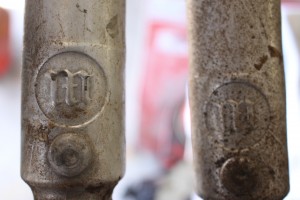
It was while riding in Germany that he crashed, sustaining 19 broken bones. He was in a coma for two weeks. Upon discharge from the hospital, he found some Royal Air Force servicemen at a nearby base that knew about Matchless models. Doing a favor for a fellow military man, they straightened the frame, got some new wheels, and made his bike roadworthy again – complete with foot rest on the left side so he could immobilize his left leg. (Old British bikes had shifter lever on the right side.)
“Those guys were fabulous,” Bagn said. “They said, ‘How the hell can you get on the bike?’ I said, ‘Try me.’” With his left leg parallel to the ground and his crutches stowed in a cradle that the soldiers had added to the bike, he rode it to Rotterdam, but couldn’t get off the bike.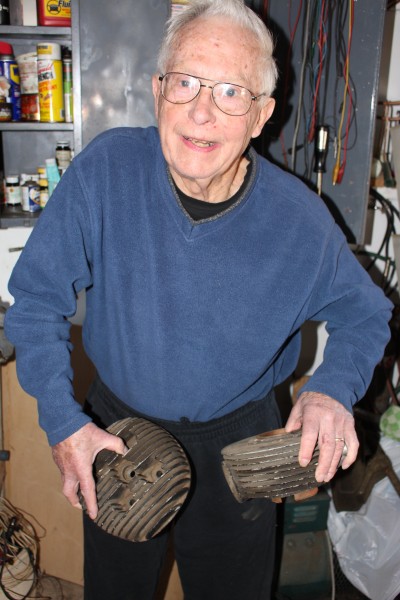
Having obtained an engineering degree, Bagn went on to have a career as a corporate executive, working for Corning Glass in Toronto and later Kentucky. He also worked for Emhart until quitting the executive suite in 1982. He then got his real estate license. Bagn bought a 36-acre farm in Torrington in 1972 and eventually gave up riding. “My last ride was probably about 1974-75,” he said.
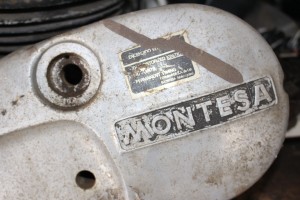 It was while selling real estate that he acquired the Montesas. A client offered him the motorcycles in lieu of commission. That was probably 1984. They’ve been sitting ever since, and got moved across the street when he downsized his holdings. His goal of restoring them never came to pass.
It was while selling real estate that he acquired the Montesas. A client offered him the motorcycles in lieu of commission. That was probably 1984. They’ve been sitting ever since, and got moved across the street when he downsized his holdings. His goal of restoring them never came to pass.
After talking about the bikes for a while, Sparks agreed to take them with the intent of determining if they were restorable. “None of it is Waterford glass,” said Bagn of the components, which Sparks loaded into the back of his pickup. The two frames, the iced-in one under the deck and the other later spied under a snow pile behind a portable garage, couldn’t be retrieved. We’re looking forward to returning after the thaw – to get them and to maybe hear some more of Bagn’s riding adventures.
 Ride CT & Ride New England Serving New England, NYC and The Hudson Valley!
Ride CT & Ride New England Serving New England, NYC and The Hudson Valley!

